Healthy Sweet Recipes
Using Carob
Healthy sweet recipes using carob are the basis of many dessert menus for "chocoholics" who desire the rich, unique experience of chocolate, but who might be allergic or sensitive to some of the components of cocoa (such as the bitter alkaloid of the cacao plant, theobromine). Carob can be adapted well to recipes calling for cocoa.

Carob grows in tropical and subtropical countries, mainly in the part of Europe bordering the Mediterranean Sea and in Northern Africa (the picture above shows a tree with carob pods from the Spanish island of Mallorca). Interestingly, it is from the legume family (like beans, lentils and peas). But unlike the seed being eaten, the pods are the part of the plant that are most frequently consumed, and the pods are what is ground into powder, or flour, for wholesome dessert recipes all over the world.
There are actually other means of using carob, as in savoury dishes and breads. In the Bible, carob is speculated to have been the "locusts" referred to as eaten by John the Baptist with wild honey. (The Greek of the time word used the word 'egkrides' to refer to cakes or bread made from the flour of the carob bean, very similar to the Greek word for the insect locusts, which was 'akrides'.) At that time in history, using carob to feed livestock and for human consumption during times of famine, meant that it was far from the status of today's healthy sweet treats. Carob pods were also referred to, disparagingly, in the Parable of the Prodigal as the food that was fed to the hogs in the "far land." The degenerate young man found himself chowing down with the hogs, competing for the carob pods.
Somewhere along the way carob reached the status of "royal standard" for determining the value of precious gems and gold. The points on the jewel were measured against carob seeds. The word "carat" derives from the seeds in the pod. The carob was also used as a sweetener up until today's more common processed sugars made their way onto the market. As well as being the stuff of healthy sweet recipes, using carob ensures a boost in one's nutritional profile. Carob is mineral-rich with calcium and iron; it also has B-vitamins and antioxidants. It does NOT contain theobromine or caffeine, the bitter alkaloids in chocolate that can cause sleep disturbances, jitters, acne, and headaches.
Some would protest that using carob in a recipe that pretends to be a chocolate confection is a little like trying to pass Postum off as Cafe Latte. Indeed, I met a young woman who states that in her childhood and youth her mother "carob'd [them] to death" and she is unable to force herself to indulge in any rendition of those healthy sweet recipes from her past. I would agree that carob has limited flavour similarity to chocolate. In fact, once one begins to appreciate the pleasant taste of carob with its own unique 'je ne sais quoi' signature, the comparison to chocolate is just as precious as the comment that "chocolate is poor man's carob."






